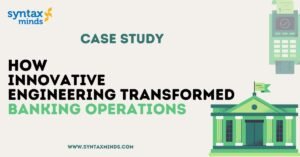In today’s rapidly evolving banking landscape, staying ahead of the curve requires innovative approaches to customer service and operational efficiency. One such approach gaining traction is Prompt Engineering, a methodology focused on optimizing customer interactions through intelligent automation and personalized prompts. In this article, we’ll explore the benefits of implementing Prompt Engineering in the banking industry, illustrated by a real-world example.
Enhanced Customer Experience:
Prompt Engineering empowers banks to deliver personalized and contextually relevant prompts to customers across various touchpoints, such as mobile apps, websites, and ATMs. By leveraging customer data and advanced analytics, banks can anticipate customer needs and preferences, offering tailored recommendations and assistance in real-time. For example, a customer visiting the bank’s website to inquire about mortgage options may receive a prompt highlighting relevant mortgage products based on their financial profile and browsing history. This personalized approach enhances the overall customer experience, fostering loyalty and satisfaction.
Streamlined Operations:
Automating routine banking tasks and inquiries through Prompt Engineering can significantly reduce operational overhead and improve efficiency. For instance, implementing chatbots equipped with natural language processing capabilities allows customers to perform transactions, check balances, and resolve inquiries without human intervention. By automating these processes, banks can allocate resources more effectively, freeing up staff to focus on high-value tasks such as financial advising and relationship building.
Fraud Prevention and Security:
Prompt Engineering can play a crucial role in enhancing fraud prevention and security measures within the banking industry. By analyzing customer behavior and transaction patterns in real-time, banks can detect suspicious activity and prompt customers to verify their identity or flag potentially fraudulent transactions. For example, if a customer attempts to make a large withdrawal from an ATM in a location they rarely visit, the bank may send a prompt to their mobile device asking them to confirm the transaction’s legitimacy. This proactive approach helps mitigate fraud risk and safeguard customer assets.
Improved Cross-Selling and Upselling Opportunities:
By leveraging data-driven insights and predictive analytics, Prompt Engineering enables banks to identify cross-selling and upselling opportunities tailored to each customer’s financial needs and goals. For example, a customer who recently opened a savings account may receive a prompt suggesting complementary products such as a certificate of deposit or investment portfolio management services. By presenting relevant offers at the right time and through the right channels, banks can increase revenue streams while providing value-added services to customers.

Real-World Example:
Consider a large retail bank that implemented Prompt Engineering across its digital platforms. Using predictive analytics, the bank identified a segment of customers who frequently traveled internationally for business. Leveraging this insight, the bank developed a proactive prompt system that alerted these customers to travel-related services, such as foreign currency exchange, travel insurance, and fraud alerts for international transactions. As a result, customers received timely assistance and relevant offers tailored to their travel needs, enhancing their banking experience and loyalty to the bank.
In conclusion,
Prompt Engineering offers significant benefits to the banking industry, including enhanced customer experience, streamlined operations, improved security, and increased revenue opportunities. By leveraging data-driven insights and intelligent automation, banks can deliver personalized and proactive prompts that anticipate customer needs, drive engagement, and foster long-term relationships. Embracing Prompt Engineering can position banks for success in an increasingly competitive and digital-centric market landscape.

